 W
WThe Royal Small Arms Factory ADEN is a 30 mm revolver cannon used on many military aircraft, particularly those of the British Royal Air Force and Fleet Air Arm. Developed post-World War II primarily to meet British Air Ministry's requirement for increased lethality in aircraft armament, the cannon was fired electrically and is fully automatic once it is loaded.
 W
WThe Bordkanone 3,7 was a German 3.7 cm (1.46 in) anti-tank/bomber autocannon of World War II and based on the earlier 3.7 cm (1.46 in) Flak 18 made by Rheinmetall.
 W
WThe Colt Mk 12 is a 20 mm autocannon that was widely used by the United States Navy after World War II.
 W
WThe Darne machine gun is a machine gun of French origin.
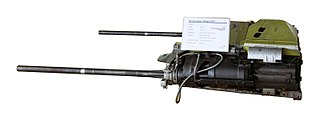 W
WThe DEFA cannon is a family of widely used French-made aircraft revolver cannon firing standard 30 mm caliber NATO rounds.
 W
WThe M134 Minigun is a 7.62×51mm NATO six-barrel rotary machine gun with a high rate of fire. It features a Gatling-style rotating barrel assembly with an external power source, normally an electric motor. The "Mini" in the name is in comparison to larger-caliber designs that use a rotary barrel design, such as General Electric's earlier 20 mm M61 Vulcan, and "gun" for the use of rifle ammunition as opposed to autocannon shells.
 W
WThe M61 Vulcan is a hydraulically, electrically or pneumatically driven, six-barrel, air-cooled, electrically fired Gatling-style rotary cannon which fires 20 mm rounds at an extremely high rate. The M61 and its derivatives have been the principal cannon armament of United States military fixed-wing aircraft for sixty years.
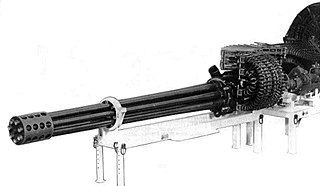 W
WThe General Electric GAU-8/A Avenger is a 30 mm hydraulically driven seven-barrel Gatling-style autocannon that is typically mounted in the United States Air Force's Fairchild Republic A-10 Thunderbolt II. Designed specifically for the anti-tank role, the Avenger delivers very powerful rounds at a high rate of fire. The GAU-8/A is also used in the Goalkeeper CIWS ship weapon system, which provides defense against short-range threats such as highly maneuverable missiles, aircraft, and fast maneuvering surface vessels. The GAU-8/A is currently produced by General Dynamics.
 W
WThe M2 machine gun or Browning .50 caliber machine gun is a heavy machine gun designed toward the end of World War I by John Browning. Its design is similar to Browning's earlier M1919 Browning machine gun, which was chambered for the .30-06 cartridge. The M2 uses the much larger and much more powerful .50 BMG cartridge, which was developed alongside and takes its name from the gun itself. It has been referred to as "Ma Deuce", in reference to its M2 nomenclature. The design has had many specific designations; the official US military designation for the current infantry type is Browning Machine Gun, Cal. .50, M2, HB, Flexible. It is effective against infantry, unarmored or lightly armored vehicles and boats, light fortifications, and low-flying aircraft.
 W
WThe General Electric GAU-13/A is a 30 mm electric Gatling-type rotary cannon derived from the GAU-8 Avenger cannon.
 W
WThe M2 machine gun or Browning .50 caliber machine gun is a heavy machine gun designed toward the end of World War I by John Browning. Its design is similar to Browning's earlier M1919 Browning machine gun, which was chambered for the .30-06 cartridge. The M2 uses the much larger and much more powerful .50 BMG cartridge, which was developed alongside and takes its name from the gun itself. It has been referred to as "Ma Deuce", in reference to its M2 nomenclature. The design has had many specific designations; the official US military designation for the current infantry type is Browning Machine Gun, Cal. .50, M2, HB, Flexible. It is effective against infantry, unarmored or lightly armored vehicles and boats, light fortifications, and low-flying aircraft.
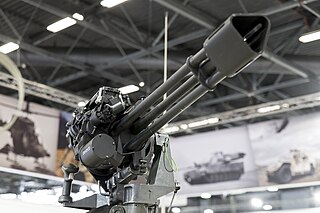 W
WThe GAU-19/A is an electrically-driven, three-barrel rotary heavy machine gun that fires the .50 BMG (12.7×99mm) cartridge.
 W
WThe GIAT 30 is a series of 30 mm cannon developed to replace the DEFA 550 series weapons on French military aircraft.
 W
WThe Gryazev-Shipunov GSh-6-23 is a six-barreled 23 mm rotary cannon used by some modern Soviet/Russian military aircraft.
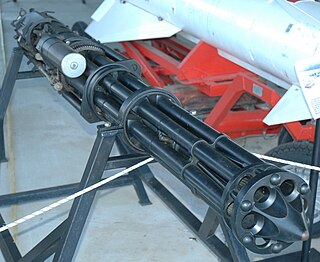 W
WThe Gryazev-Shipunov GSh-6-30 is a Russian 30 mm rotary cannon aircraft-mounted and naval autocannon used by Soviet and later CIS military aircraft. The GSh-6-30 fires a 30×165mm, 390 g projectile.
 W
WA gun pod is a detachable pod or pack containing machine guns, autocannons or rotary cannons and ancillaries, mounted externally on a vehicle such as a military aircraft which may or may not also have its own guns.
 W
WThe HS.404 is an autocannon originally designed and produced by Spanish/French company Hispano-Suiza in the mid-1930s. It was widely used as an aircraft, naval and land-based weapon by French, British, American and other military services, particularly during World War II. The cannon is also referred to as Birkigt type 404, after its designer Marc Birkigt and later versions based on British development are known as 20 mm Hispano.
 W
WThe HS.820 was a 20 mm caliber autocannon developed by Hispano-Suiza primarily for aircraft use, but more widely used in a series of ground-based anti-aircraft guns. After Oerlikon purchased Hispano's armaments division in 1970, the HS.820 became the Oerlikon KAD, supplanting Oerlikon's own KAA and KAB weapons in the process. A US-built model, the M139, saw some use on vehicles.
 W
WThe Ho-5 was a Japanese aircraft autocannon used during World War II. Developed from the Ho-103 machine gun, it was a version of the American Model 1921 Browning aircraft machine gun. It replaced the Ho-1 and Ho-3 in general service. The Ho-5 was belt-fed using typical Browning-style steel disintegrating links. The cartridge used was a shortened version of the Allied 20 x 110mm Hispano-Suiza HS.404.
 W
WThe 12.7mm Type 1 (1941) was a Japanese aircraft machine gun widely used during World War II and also known as the Ho-103. It was based on the American .50-caliber M1921 aircraft Browning machine gun.
 W
WThe Ho-301 was a Japanese 40 millimeter calibre autocannon that saw limited use during World War II, on Japanese Army Nakajima Ki-44 and Kawasaki Ki-45 KAI aircraft. It was unusual in using caseless ammunition. Although the effective range of the cannon was only 150 meters (490 ft), the Ho-301 was light and rapid-firing for its caliber.
 W
WKarabin maszynowy wz. 36, also known as Karabin lotniczy uniwersalny wz. 36 was a Polish 7.9 mm calibre aerial machine gun of the 1930s. It was a further modified version of Karabin maszynowy wz. 33, itself a modification of the successful Ckm wz.30 multi-purpose HMG.
 W
WThe Lewis gun is a First World War–era light machine gun. Designed privately in America but not adopted, the design was finalised and mass-produced in the United Kingdom, and widely used by troops of the British Empire during the war. It had a distinctive barrel cooling shroud and top-mounted pan magazine. The Lewis served to the end of the Korean War. It was also widely used as an aircraft machine gun, almost always with the cooling shroud removed, during both World Wars.
 W
WThe idea of the gun pod as a concept largely came into its prime during and after World War II. So-called "package gun" installations on US medium and light bombers, such as the B-25 Mitchell and A-26 Invader, were probably the first such attempts by the United States military. One of the primary ideas was to provide additional suppression of ground defenses during attack runs, primarily while conducting maritime interdiction, and the extra armament gave the aircraft additional firepower.
 W
WThe M39 cannon is a 20 mm caliber single-barreled revolver cannon developed for the United States Air Force in the late 1940s. It was used on a number of fighter aircraft from the early 1950s through the 1980s.
 W
WThe M61 Vulcan is a hydraulically, electrically or pneumatically driven, six-barrel, air-cooled, electrically fired Gatling-style rotary cannon which fires 20 mm rounds at an extremely high rate. The M61 and its derivatives have been the principal cannon armament of United States military fixed-wing aircraft for sixty years.
 W
WThe M75 is a 40mm automatic grenade launcher that was used primarily as an aircraft weapon in United States service and was one of the first weapons to use the high velocity 40x53mm grenade.
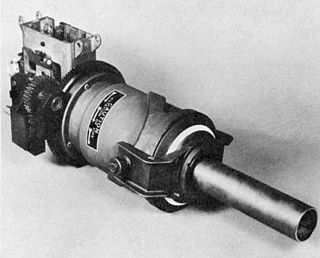 W
WThe M129 is a 40 mm automatic grenade launcher that was used as an aircraft weapon in United States service. It was developed from the earlier M75 and was capable of using both the high-velocity 40x53 mm grenade and the lower velocity 40x46 mm grenade.
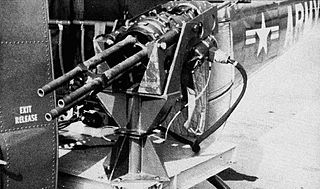 W
WThe M197 electric cannon is a 20 mm three-barreled electric Gatling-type rotary cannon used by the United States military.
 W
WThe M230 Chain Gun is a 30 mm (30×113 mm), single-barrel chain-driven autocannon, using external electrical power to cycle the weapon between shots. It was designed and manufactured originally by Hughes Helicopters in Culver City, California. The company was acquired by McDonnell Douglas Helicopters in 1985, which merged into Boeing Corporation in 1997. In 2002, it was sold again to Alliant Techsystems, which merged with Orbital Sciences Corporation in 2015 to form Orbital ATK and was, in turn, bought out by Northrop Grumman in 2018. As of 2019, it is produced by Northrop Grumman Innovation Systems.
 W
WThe M240, officially the Machine Gun, 7.62 mm, M240 or unofficially the M240 Bravo, is the U.S. military designation for the FN MAG, a family of belt-fed, gas-operated medium machine guns that chamber the 7.62×51mm NATO cartridge.
 W
WThe M621 is a 20 mm automatic cannon of French design, developed by Nexter as on-board armament for armored vehicles, aircraft, helicopters and small coastal vessels of the French Navy.
 W
WThe M1919 Browning is a .30 caliber medium machine gun that was widely used during the 20th century, especially during World War II, the Korean War, and the Vietnam War. The M1919 saw service as a light infantry, coaxial, mounted, aircraft, and anti-aircraft machine gun by the U.S. and many other countries.
 W
WThe BK 27 is a 27 mm (1.063 in) caliber revolver cannon manufactured by Mauser of Germany. It was developed in the late 1960s for the MRCA program that ultimately became the Panavia Tornado.
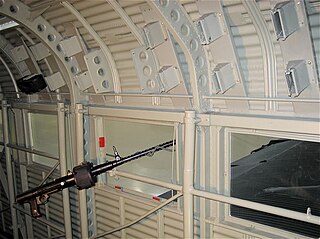 W
WThe MG 15 was a German 7.92 mm machine gun designed specifically as a hand manipulated defensive gun for combat aircraft during the early 1930s. By 1941 it was replaced by other types and found new uses with ground troops.
 W
WThe MG 81 was a German belt fed 7.92×57mm Mauser machine gun which was used in flexible installations in World War II Luftwaffe aircraft, in which capacity it replaced the older drum magazine-fed MG 15.
 W
WThe MG 131 was a German 13 mm caliber machine gun developed in 1938 by Rheinmetall-Borsig and produced from 1940 to 1945. The MG 131 was designed for use at fixed, flexible or turreted, single or twin mountings in Luftwaffe aircraft during World War II.
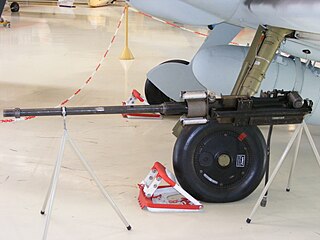 W
WThe MG 151 was a German 15 mm aircraft-mounted autocannon produced by Waffenfabrik Mauser during World War II. Its 20mm variant, the 20 mm MG 151/20 cannon, was widely used on German Luftwaffe fighters, night fighters, fighter-bombers, bombers and ground-attack aircraft. Salvaged guns saw post-war use by other nations.
 W
WThe MG FF was a drum-fed, blowback-operated, 20 mm aircraft autocannon, developed in 1936 by Ikaria Werke Berlin of Germany. It was a derivative of the Swiss Oerlikon FF F cannon, with the Oerlikon FF design itself a development of the Imperial German World War I Becker 20 mm cannon, and was designed to be used in space-limited, fixed mountings such as inside aircraft wings, although it saw use as both an offensive and a defensive weapon, in both fixed and flexible format. It saw widespread use in those roles by the German Luftwaffe, particularly during the early stages of World War II, although from 1941 onwards it was gradually replaced by the Mauser firm's 20 mm MG 151/20. MG FF stands for Maschinengewehr Flügel Fest, which translates into "machine gun, wing, fixed"; this reflects the fact that in Luftwaffe practice guns of 20 mm or less were designated as "machine guns" (maschinengewehr) as opposed to larger "machine cannons", or autocannons, which were "MK", for maschinenkanone The "wing, fixed" part reflects the fact that the primary motivation behind its design was to create a 20 mm caliber weapon that was compact and light enough to be mounted in the wings of aircraft, especially fighters.
 W
WThe M134 Minigun is a 7.62×51mm NATO six-barrel rotary machine gun with a high rate of fire. It features a Gatling-style rotating barrel assembly with an external power source, normally an electric motor. The "Mini" in the name is in comparison to larger-caliber designs that use a rotary barrel design, such as General Electric's earlier 20 mm M61 Vulcan, and "gun" for the use of rifle ammunition as opposed to autocannon shells.
 W
WThe MK 101 is the designation of a 30 mm autocannon used in German combat aircraft during World War II. Although accurate and powerful, with a high muzzle velocity, it was very heavy, with a low rate of fire, which limited its production.
 W
WThe MK 108 was a 30 mm caliber autocannon manufactured in Germany during World War II by Rheinmetall‑Borsig for use in aircraft.
 W
WThe MK 214A was a 50 mm (1.969 in) calibre auto-cannon designed by Mauser Werke AG, for use on Messerschmitt Me 262 and Me 410 bomber-destroyers.
 W
WThe Oerlikon KCA is a Swiss 30 mm (1.181 in) gas-operated single-barrel revolver cannon developed for aircraft use. Its most noticeable use was on the Saab 37 Viggen fighter mounted on a conformal pod. The KCA fires a 30 mm × 173 mm shell that is 50% heavier than the NATO standard ammunition used on ADEN and DEFA cannon. It can fire up to 1350 rounds per minute at a muzzle velocity of 1030 m/s, with an effective range of 2,500 m (8,200 ft)
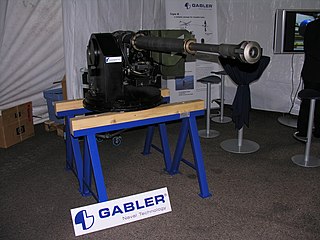 W
WThe RMK 30 is a recoilless 30 mm caliber autocannon firing caseless 30 × 250 mm ammunition cartridges. The gun was developed by the German company Mauser, which is now a subsidiary of the Rheinmetall group.
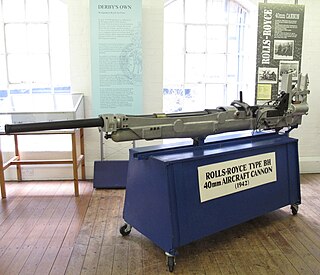 W
WThe Rolls-Royce 40mm Cannon was a project first proposed in late 1938 to produce a cannon for mounting in aircraft which could cause sufficient damage to bring down a large bomber. It was also envisioned to be a suitable weapon for destroying tanks from the air. Experimental versions of the cannon were produced including some with a magazine or belt feed for the ammunition. Examples were fitted to a Beaufighter and Hurricane for testing, although never used in action. Continued development of the aircraft cannon to iron out problems came to an end in 1943 when the Air Ministry lost interest in it and had started to favor the rocket projectile as its aircraft anti-tank weapon of choice.
 W
WSchräge Musik, which may also be spelled Schraege Musik, was a common name for the fitting of an upward-firing autocannon or machine gun, to an interceptor aircraft, such as a night fighter. The term was introduced by the German Luftwaffe during World War II. "Schräge Musik" was previously a German colloquialism, meaning music that featured an unusual tuning and/or time signature. By itself, the word Schräge has often been translated as "slanting" or "oblique", although it may instead be rendered into English as "weird" or "strange".
 W
WA gun turret is a mounting platform from which weapons can be fired that affords protection, visibility and ability to turn and aim. A modern gun turret is generally a rotatable weapon mount that houses the crew or mechanism of a projectile-firing weapon and at the same time lets the weapon be aimed and fired in some degree of azimuth and elevation.
 W
WType 3 was a Japanese Navy aircraft machine gun used during World War II. It was based on the American M2 Browning machine gun but used the 13.2x96mm Hotchkiss cartridge.
 W
WThe Type 92 7.7mm machine gun was developed for aerial use for the Imperial Japanese Navy in 1932. The Type 92 is a light machine gun and not to be confused with the similarly named Type 92 Heavy Machine Gun.
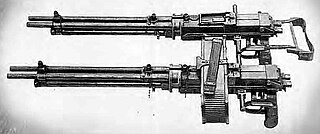 W
WThe Type 100 is a double barrel machine gun of Japanese origin. The weapon is gas operated and fed from an overhead magazine. An example can be seen at the Satria Mandala Museum in Jakarta.
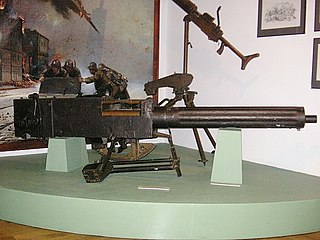 W
WThe Vickers .50 machine gun, also known as the 'Vickers .50' was similar to the .303 inches (7.70 mm) Vickers machine gun but enlarged to use a larger-calibre 0.5-inch (12.7 mm) round. It saw some use in tanks and other fighting vehicles but was more commonly used as a close-in anti-aircraft weapon on Royal Navy and Allied ships, typically in a four-gun mounting. The Vickers fired British .50 Vickers (12.7×81mm) ammunition, not the better known American .50 BMG (12.7×99mm).
 W
WThe Vickers K machine gun, known as the Vickers Gas Operated in British service, was a rapid-firing machine gun developed and manufactured for use in aircraft by Vickers-Armstrongs. The high rate of fire was needed for the small period of time when the gunner would be able to fire at an attacking aircraft. The weapon was also adopted for land use during World War II.
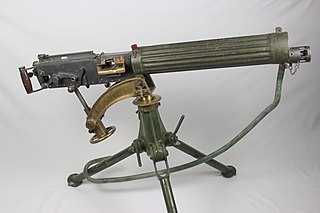 W
WThe Vickers machine gun or Vickers gun is a name primarily used to refer to the water-cooled .303 British (7.7 mm) machine gun produced by Vickers Limited, originally for the British Army. The machine gun typically required a six- to eight-man team to operate: one fired, one fed the ammunition, the rest helped to carry the weapon, its ammunition, and spare parts. Not to be confused with the Maxim machine gun, it was in service from before the First World War until the 1960s, with air-cooled versions of it on many Allied World War I fighter aircraft.
 W
WThe Vickers Class "S" was a 40 mm (1.57 in) cannon used to arm British aircraft for attacking ground targets in the Second World War.
 W
WThe XM214 is an American prototype 5.56 mm rotary-barreled machine gun. It was designed and built by General Electric. Also known as Microgun, the XM214 was a scaled-down smaller and lighter version of the M134 minigun, firing M193 5.56×45mm ammunition.